Abigail Szewczyk
The Amnesia of Beachcombers
As a child growing up on the Gulf Coast of Florida, I was made aware every day of the past lives of that land. Some of the animal and human ghosts that constantly beckoned to me still possessed versions of their living forms in the present. Others were only palpable in a whisper, an odd feeling of combined curiosity, desire and sadness, sentiments sometimes echoed in lines from Florida history books with disappointingly didactic illustrations.
Walking to school, I stumbled across remainders of the land’s original inhabitants without even trying. I began to gather these lingering pieces as a little girl, not knowing what they were at first, but sensing some significance. Black, shiny fragments lay upon the loose, burning sand in my neighborhood: heavy hunks of fossilized manatee rib, smooth and cool in the heat of the day; stingray crushing mouth plates and barbs, sometimes shockingly large, the width of my palm, lying on the side of the road near the driveway; sections of turtle and tortoise shell turned to stone through time; alligator scoots—small bony squares that make up the under-skin armor of these water lizards; and above all, shed teeth—petrified horse teeth, pieces of mastodon and mammoth teeth, deer teeth, and ubiquitous shark teeth of so many shapes, sizes, colors and sharpness, some broken in half, others still serrated enough to puncture skin, and on the rarest occasion, a few bespeaking the unthinkable scale of the great megalodons.
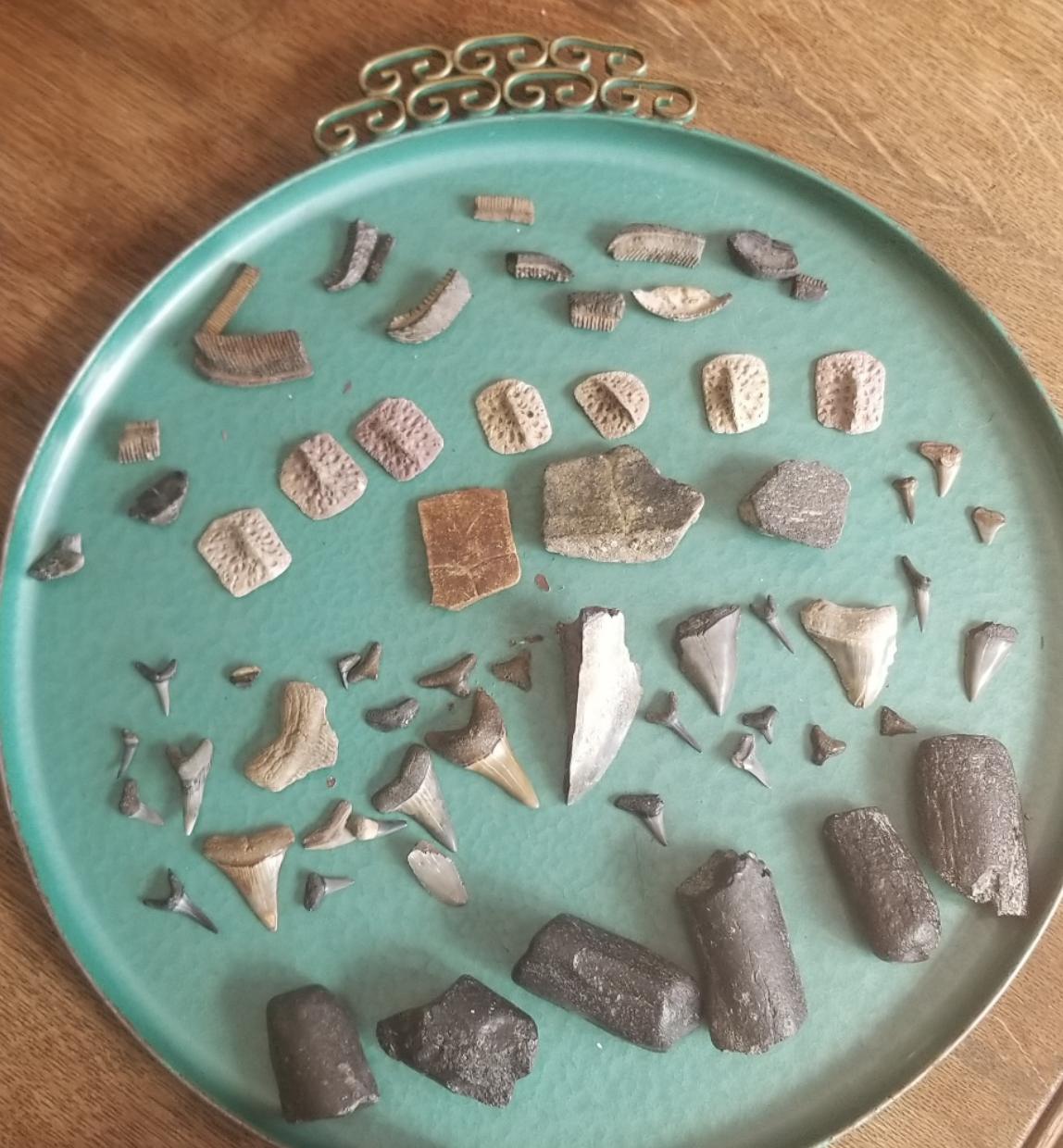
Finding prehistoric fragments of animals still surviving in Florida, albeit in less gargantuan versions and in far fewer numbers than had been the case in the prehistoric past, made sense to me. They had always lived on the land and in the water now called Florida, and still did in evolved forms. They would continue to do so beyond my lifetime, I assumed when I was a child. This was both a mystery and a comfort: the long horizon of time’s duration.
Today though, just one century after the development of motorboat technology, it is more of a question of hope that manatees and alligators will still populate the rivers and springs in the future. The manatees are the most difficult to behold, because their backs always, always bear the marks of massive wounds and scars—the result of speedboat engine blades slicing through their thick skins despite the high speed warnings in their wintertime birthing waterways. Manatee fossils, when you find them now, are therefore more like warnings of what is ahead than reminders of what has passed.
***
Nearly every Florida roadside, path, or beach contains debris from the massive tribal system that once covered the land. If you look and listen intuitively, these clues tell you many things about what the land is and was and who lived there before.
The Tocobaga Tribe of Tampa Bay died out by the mid-1600s after succumbing to the horrendous diseases brought by the arrival of the Spanish conquistador Pánfilo de Narváez a century earlier. The name “Tampa” may have meant “sticks of fire” in the language of the Calusa, another large tribe that lived south of this little peninsula of “Pinellas,” which juts out of the landmass of the greater peninsula of Florida and into the Gulf. Some people think that this notion of “sticks of fire” also could have been a simple linguistic misunderstanding between invader and inhabitant. I like to think that the name Tampa referred to the intensity of the lightning activity that occurs in the area.
The Seminole Tribe of Florida remains a vibrant indigenous culture today. In contrast, all that is materially left of the Tocobaga tribal society, beyond a few community museum displays, are their abundant trash middens still visible on many waterways around Tampa Bay, as well as dispersed tool fragments, and a handful of temple mounds that evaded being bulldozed for landfill development. Usually, if you see any kind of hill in the topographically flat Tampa Bay area, even a five foot-high hill, it’s really a Tocobaga shell midden or a temple mound.
The various shell tools of the Tocobaga were the most moving for me when I occasionally came across them laying on the ground in full sun, since as a teenager I eventually learned to see the way in which the natural resources of the area, still so abundant despite endless development, made up the very fabric of their daily lives. Horse conch hammers, picks, and adzes, with the sharp tip of the shell shaved off to make a flat surface, and holes punched in for long or short stick handles—or the outer shell stripped away in order to expose the strong interior core—were great for all kinds of food-related work—flattening and mashing roots, digging out other kinds of shellfish in the shore break, scooping the meaty flesh of whelks, prying the spines from Gulf fishes…
There were also animal bones ground down to delicate spindles, and the stripped whorls of horse conch interiors, spiral-shaped tools which helped open the thousands of oysters consumed from the estuary, the staple of the indigenous diet and also the main building material for their temples and mounds. Especially emotional for me were the small, elaborate shells delicately punctured with holes, for stringing onto bead necklaces and garments. Sometimes the bone segments smoothed into spiral shapes were also used as hair picks, although I only gathered this from illustrations.
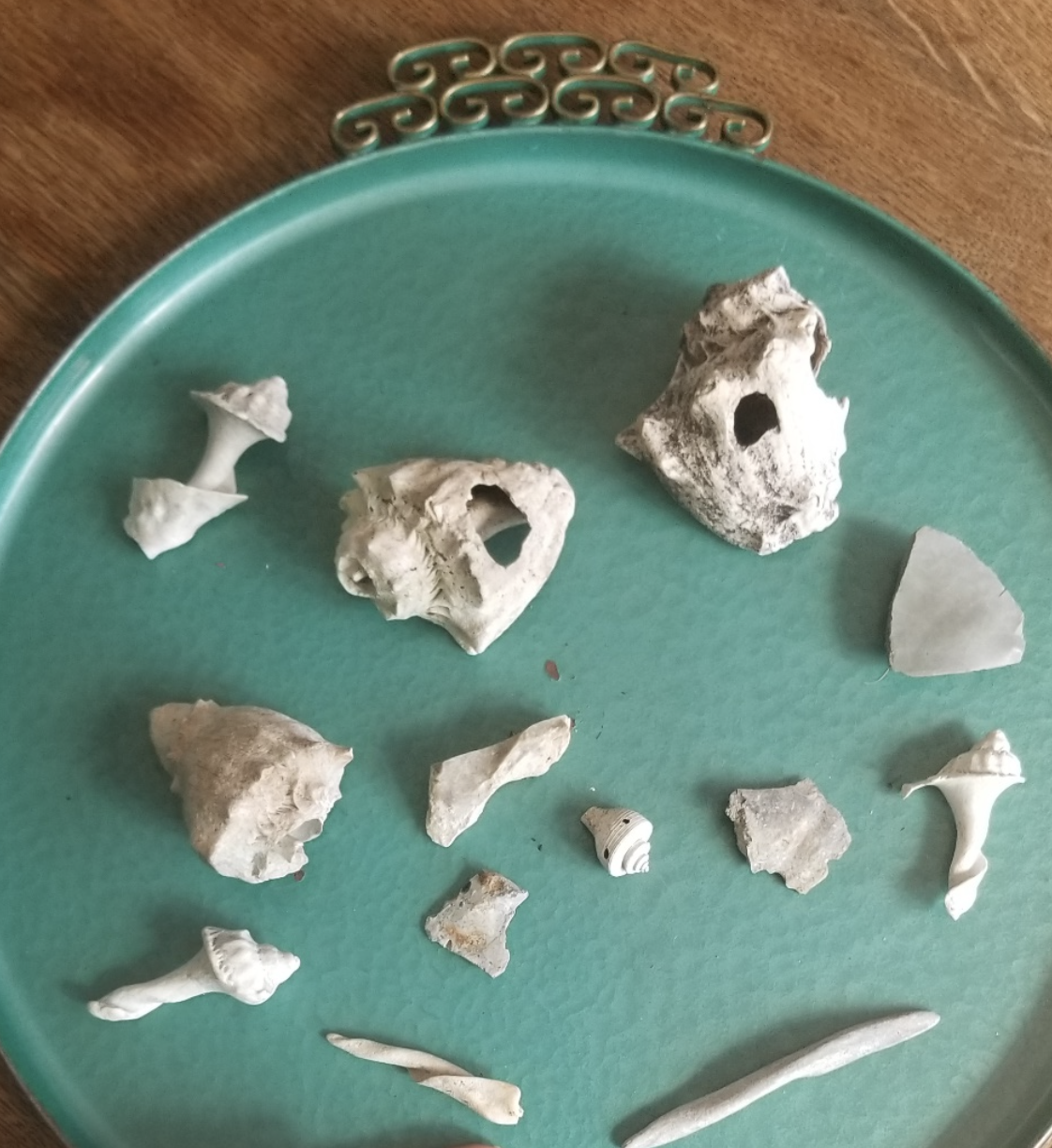
Shells furnished tools, adornment, diet, and building material for the Tocobaga of Tampa. Stones and wood made reliable implements too, as they did and do all over the world for tribal societies, but shells were a distinctive food and tool staple of Florida indigenous peoples. The Tocobaga were great archers, but finding their churt arrow points today is a rarity. Wood cannot stand the test of time in Florida’s atmosphere of total humidity.
***
Now all of this knowledge about the practical and alimentary uses of local natural materials is largely forgotten by us, the occupants of this colonized land. Tocobaga shell tools with their unique puncture and shaping marks are almost always overlooked by eager beachcombers looking for the perfect, new, shiny shell. Tocobaga shell tools simply look like old, broken shells. Beachcombers today prefer living shells that they find alive in the water and later kill by leaving the shell and its hapless inhabitant out in the sun, so that the shell is perfectly preserved in its mortified living-dead state for a new life of useless shelf-sitting. Beachcombed shells are ghosts of forgetfulness. Beachcombers in Florida walk a zombie walk.
Florida’s past animal and human inhabitants lived a life so overwhelmingly abundant and prolonged that their fragments persist constantly in the present, everywhere in our peripheral vision and just beyond the reach of our amnesiac collecting hands. When scores of beachcombers glean the shores of Florida beaches every dawn and dusk, as they are wont to do in all seasons, they impinge their anxious wandering search onto the horizon around them, stealing future shell homes from searching crustaceans, who are compelled by nature to switch from smaller to larger shells as they grow over time.
Amnesiac beachcombers leave behind the fossilized or fragmented reminders of former mammal, reptile, avian and human inhabitants of Florida, for the most part, however, since these are so clearly not new. Their shelf-life has already expired a thousand times over and they are unfit for petrified death-life on display shelves. Fossilized bones are especially puzzling to beachcombers in their opaque black shininess and dolorous heft. The feeling of an intuited message from the past is there, but it usually doesn’t make it across the divide of time. Fossils usually garner a glance or two from the hungry combers but are ultimately tossed aside in order to make room for even more shells of endless variety. Fossil shark teeth are the single exception to this rule, being the ultimate prize of the beachcomber due to their aquarium notoriety.
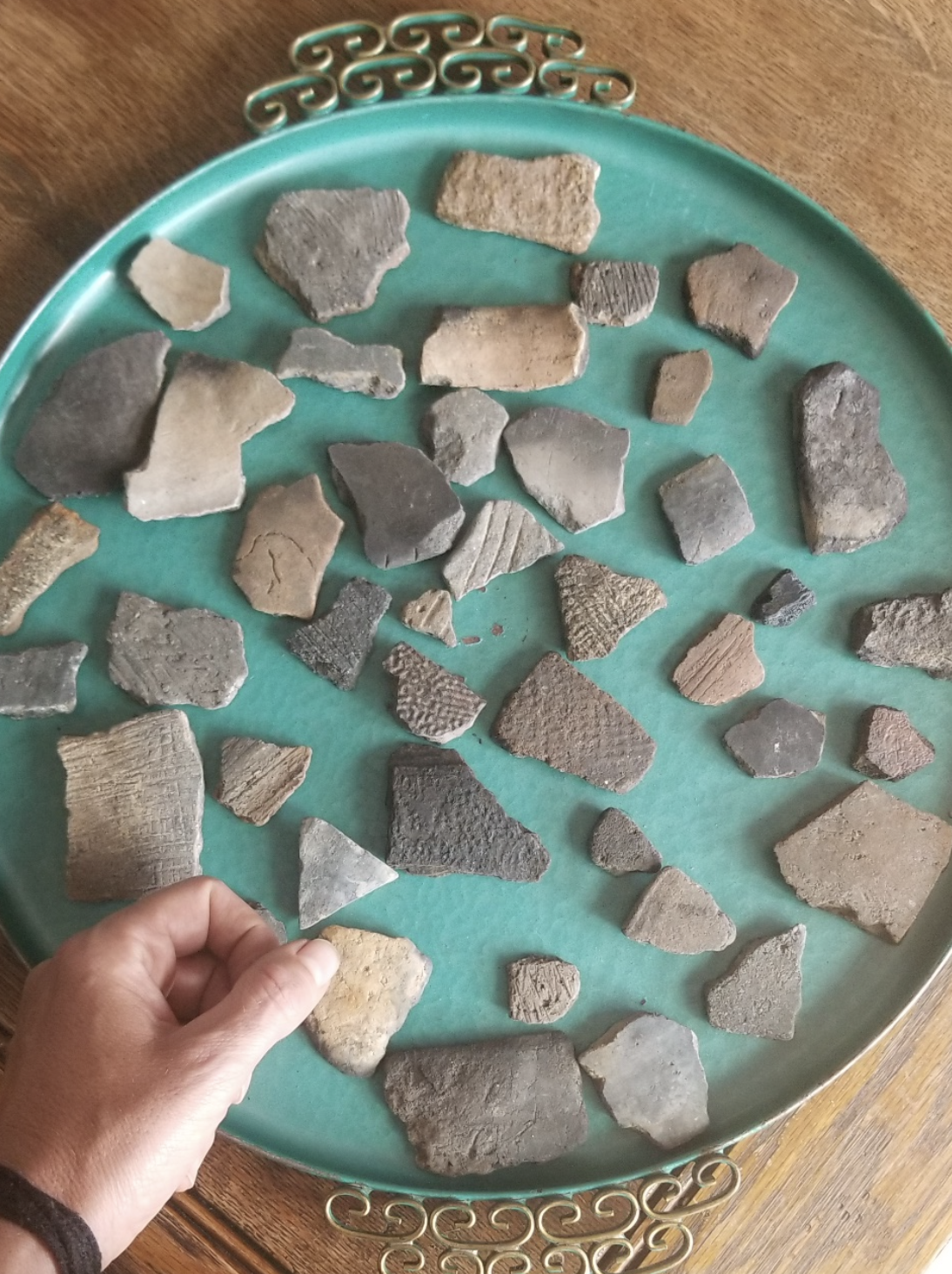
***
The other kind of Tocobaga utensils that I came across lying on the ground just about every month when I was a child were pottery sherds. The Tocobaga were expert potters. They combined clay with sand to create many kinds of vessels for the most mundane of uses. Pieces of the pots that the Tocobaga casually threw away after these items became chipped or worn can easily be found scattered on roadsides and across suburban front yards. Sometimes these ubiquitous sherds can be discovered in fields where fragments of skeet-shooting clays mix in, because Floridians love guns. This creates a bewildering heterodoxy of new-old.
The sherds have a pleasing visual effect when gathered together, due to their myriad shapes, sizes and colors, and also the subtle gradations of texture: repeating lines incised into the clay with a shell or stick, hatch marks left over from a reed basket that allowed the vessel to be carried with a handle, striations of grasses that were added to the clay to strengthen it during the firing process. The sherds are the literal manifestation of the intimate way in which the Tocobaga interacted with and shaped the physical land—the sand, dirt and clay— of Tampa Bay.
***
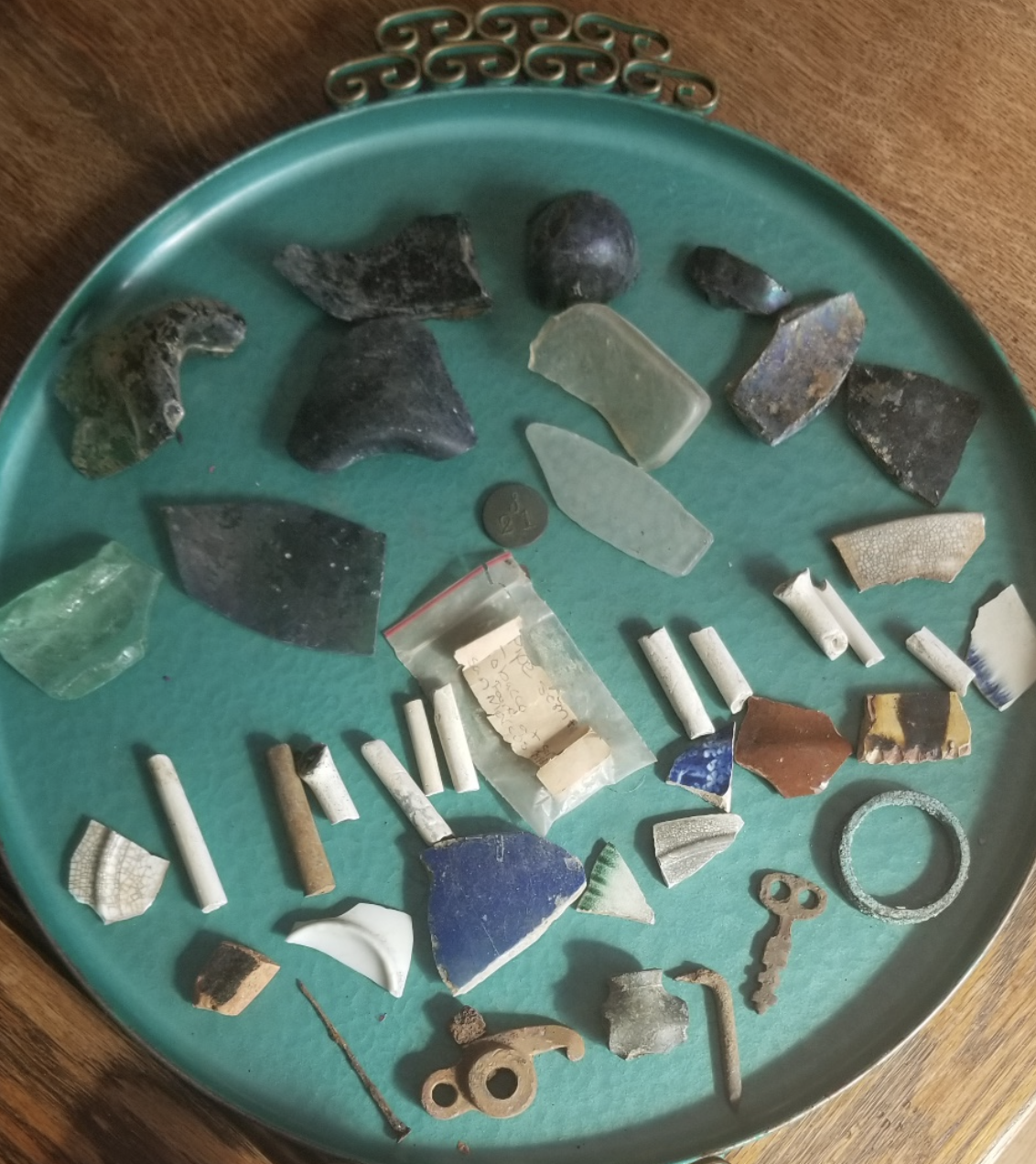
Less often, gazing down at the ground in Florida results in communication with the land’s colonial era. The material identity of these remnants are quite different in feel and sensibility: glass, metal, porcelain, ceramic; British, Spanish, American items, as well as those imported to the colonies from Asia. Colonial pipe stems are the most common. The colonists broke off pieces of their long clay pipes over time as they used them—a means of keeping the pipe clean—so this was one of the earliest forms of disposable product. Sometimes the tobacco pieces are still in tact inside the narrow shaft of the stem.
What is most striking in contrast to the indigenous items is that these colonial fragments do not come from Florida. This is an obvious point, but a significant one nonetheless. These items are not made of the land and animals of that unique place. They are not constructed with local shells, bone or earth. Instead, the colonial fragments were, at some point a few hundred years ago, lost, thrown away, or left behind. They invade from elsewhere (else-place) and linger long after that initial invasion (after-presence). They are trash. Although these items also have voices of a kind, which can be heard by a keen listener who encounters them, their message is largely discontinuous. They are the things that emanate the amnesiac pulses animating the fingers of the compulsive amnesiac beachcombers: a British guinea weight without its scale, the hammer of a gun, a rust-eaten key.
Yet, what is most astonishing is how seldom I came across colonial garbage as a child. The people who had lived on the land the longest—the Tocobaga and their ancestors— were the ones who were actually the most present in the form of remainders. Their numbers as a society were far greater. Clearly, they had lived on that land infinitely longer. Their relationship to the land was deeper, more lasting and so much more abundantly reciprocal. Through the constant presence of sherds, shells and scoots that exposed themselves to the rain and sun, the surface of the earth bore this endless message: this was their home; this was how they lived. The land won’t forget.
